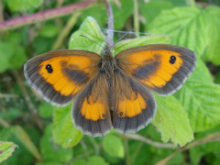
| Butterfly Conservation |
 |
| Hertfordshire & Middlesex Branch |
 |
|
|||
| Saving butterflies, moths and our environment | ||||


GatekeeperPyronia tithonusWidespread and common Distribution and Status The Gatekeeper is now widely distributed and common in the two counties although in the 1980s it was found on only the western, northern and eastern fringes of Middlesex. Like the Meadow Brown, there are distribution gaps in north east Hertfordshire, probably in the agricultural areas. Abundance is more of a concern though since there has been a significant decline since the 1980s. Pesticide spraying on field margins and neonicotinoid insecticides are likely reasons Habitat Requirements Hedgerows, woodland rides and scrubland containing tall grasses. Heaths, under cliffs and downland sites are also visited if they contain scrub Larval Foodplants Cock's-foot Dactylis glomerata, Annual Meadow-grass Poa annua, Rough Meadow-grass Poa trivialis, Sheep's Fescue Festuca ovina, Creeping Bent Agrostis stolonifera, Rye-grass Lolium spp., Common Couch Elytrigia repens Adult Food Sources Bramble Rubus fruticosus agg., Wild Marjoram Origanum vulgare, Buddleia Buddleja davidii, Common Ragwort Senecio jacobaea, Heather Calluna vulgaris Behaviour/Observation notes The Gatekeeper is often found basking on flowers for long periods in sunlit places and is an easy butterfly to photograph. The female can be confused with the female Meadow Brown for inexperienced observers. Although in most cases, the Gatekeeper has two white pupils in the eye-spots on the forewings and the Meadow Brown has only one, the differences on the hindwings are more reliable to distinguish between the two species. The upperside of the Gatekeeper normally has a white-pupilled eye-spot and the underside a row of white dots Life History Only one generation is produced each year. The butterfly's emergence begins in early July and lasts until the end of August with a few stragglers left in September. The peak usually occurs in the last week of July and first week of August. Eggs are laid singly on grasses in warm and sheltered situations but usually in shade. Larvae soon enter hibernation when they emerge. In the spring the larvae feed on the tenderest parts of grass before forming a pupa low down when fully grown Further information
UK distribution map |
Copyright Butterfly Conservation © 2019 Hertfordshire & Middlesex Branch
Privacy and Copyright Statement and Cookie Policy Statement
Butterfly Conservation
Company limited by guarantee, registered in England (2206468)
Registered Office: Manor Yard, East Lulworth, Wareham, Dorset, BH20 5QP. Tel: 01929 400 209
Charity registered in England & Wales (254937) and in Scotland (SCO39268). VAT No. GB 991 2771 89